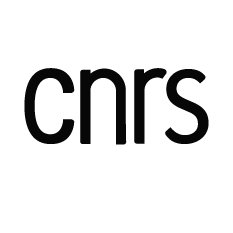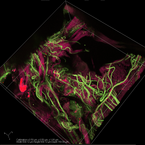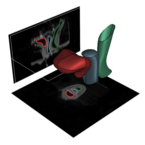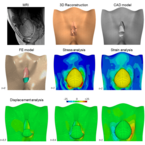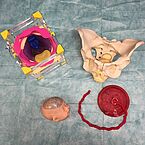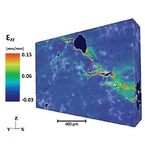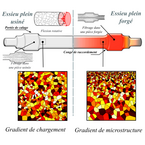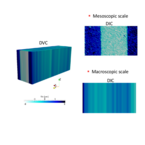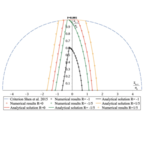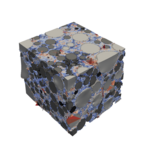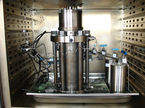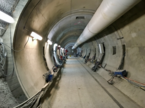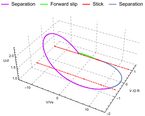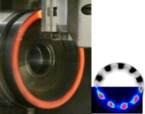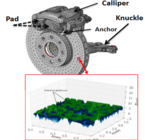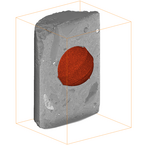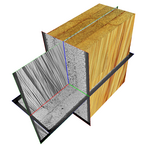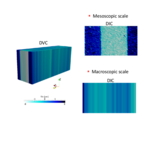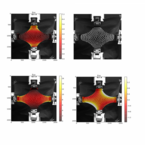Research groups
Thematic groups to meet scientific challenges
LaMcube's scientific activity is based on a coherent research theme centred on the mechanics of materials, and the sharing and pooling of methods and approaches. Research is structured into four research themes called "Thematic Groups":
BioTiM brings together mechanics and physicians working jointly on the development of patient-specific treatment and simulation tools for a new generation of healthcare around three main coupled topics, ranging from characterisation at the microstructure scale to the simulation of complex systems.
More specifically, their activities focus on:
• Characterisation of tissues from microstructure to behaviour
The characterisation of soft tissue behaviour is still a major difficulty due to the experimental conditions, the nature of the tissues, or their sampling and storage conditions. All the observations and histological analyses highlight a highly heterogeneous microstructure, consisting of a fibrous network of elastin and collagen, more or less oriented. The current results show, whatever the tissue and the anatomical site, a non-linear elastic behaviour in large deformations.
• Modeling anisotropic hyperelastic behavior
One of the challenges of BioTiM is to propose a model of soft tissue behaviour based on these experimental and microstructural observations. The proposed models are based on a directional description taking into account the anisotropies induced by the observed microstructure or the reinforcements by prosthetic textile, but also the potential damage mechanisms. The development of histologically based models thus allows for a reduction in material parameters towards a patient-specific simulation.
• Patient specific simulating tool for clinical care
The last challenge is the development of simulation tools for physiology, pathology and care that integrate the complexity of structures, systems and behaviours (geometry, interaction between organs, large transformations, hyperelasticity, etc.). To do this, BioTiM is working on the development of specific medical image analysis techniques for the semi-automatic generation of geometries and meshes for the specific simulation. The existence of a very strong dialogue between tests, images and numerical models allows generic simulation tools to be adapted to specific patient situations.
All this research applies to various medical problems such as the behaviour of the abdominal wall to improve the treatment of abdominal hernias or the mobilities of the pelvic system to improve the treatment of prolapse or to prevent injury risks during childbirth. This work makes it possible to develop planning or care support tools, but also to develop medical devices such as surgical implants or healthcare instruments. This work also makes it possible to design and produce care training simulators.
COREFoU is involved in understanding the damage and fatigue mechanisms of materials in relation to their microstructures which are determined by their manufacturing processes. Its work is mainly based on transport issues, with the aim of preventing accidental failure of mechanical parts and reducing maintenance costs by increasing service life.
The control of fatigue performance under complex structures loading requires in-depth knowledge of the behaviour of materials and damage mechanisms in relation to their microstructure. The activities of COREFoU are linked directly to those of PoEME and CoNEx. In the case of metallic, composite and polymeric materials, the aim is to propose models based on a detailed description of the microstructures and damage micromechanisms observed. This axis is based on several remarkable elements:
- Strong theoretical skills in limit analysis and adaptation or damage of polymers, composites and elastomers
- Theoretical and experimental expertise in non-linear elasticity and physically based modelling in large transformations (initial and induced anisotropies, Mullins effect, softening and tearing)
- The expertise of 2D/3D field measurements, coupled or not, at the microstructural scale
- The ISIS4D X-ray microtomography platform, for carrying out tests with in situ observations,
- The ability to develop materials with a microstructure adapted to the methods used to identify and understand physical phenomena.
Experimentally, the strategy consists of highlighting and quantifying the adaptation and accommodation mechanisms under cyclic loading. This is based on multimodal field measurements (2D/3D kinematics, thermal and crystallography) and multi-scale measurements from material to structure. The focus is on gradients (loading, geometry, microstructure) and their influence on behaviour and damage through structuring research projects such as the joint research laboratory SWIT'lab. The aim is to continue previous work on the formulation of multi-scale fatigue criteria based on the notion of adaptation. For foundry materials, the objective is to extend the results obtained in poroplasticity by limit analysis to the theory of adaptation, then to poroviscoplasticity. In the field of thermomechanical and contact fatigue, the strong interactions with the activities of µFrein should also be emphasised.
For elastomeric materials, studies are undertaken to better understand the consequences of damage phenomena at low numbers of cycles (accommodation, anisotropy, Mullins effect) on tear behaviour. This work requires close collaboration with physical chemistry laboratories in order to better control the nature of microstructures and their impact on damage and failure mechanisms.
In the case of composite materials, in collaboration with ONERA in Lille, work is continuing on proposing physically based models of behaviour and damage for laminated composites and 3D interlocks, from the static to the dynamic.
GEOM's activity is part of issues related to structures in strategic fields of application, in particular the geological storage of radioactive waste and the safety of nuclear power plant enclosures. The ambition of the research is to provide physically based answers to the challenges of stability and durability of structures, which require the explanation and control of the thermo-hydro-mechanical and chemical behavior of materials, in the short and long term.
The GEOM group is related to issues linked to strategic structures such as geological storage of radioactive waste, safety of nuclear power plant enclosures, exploitation of non-conventional hydrocarbons and acid gas sequestration. The analysis of their stability and durability are major challenges. Physically sound answers to these challenges require the explanation and control of the thermo-hydro-mechanical and chemical behaviour of the materials concerned (mainly rocks and concretes), in the short and long term.
Rocks and concretes are porous media saturated by one or more fluids; their macroscopic behaviour therefore depends directly on the interactions between the properties of the fluids, the morphology of the porous networks, the kinetics of fluid transport and the deformation, or even the modification of their skeletons. Due to heterogeneities, the application of a thermal or water field can also generate non-uniform local stress fields leading to inelastic deformation and/or micro-cracking. Finally, in many areas, these materials may also be subject to chemical degradation, either by calcium dissolution of cementitious materials, or by dissolution of the contact surfaces of limestone rocks due to a pressure-dissolution process, or by subcritical microcrack propagation due to stress corrosion. This chemical degradation can significantly affect the mechanical and transport properties.
The major scientific challenges are :
- to understand and characterize the mechanisms of deformation, cracking and degradation at different scales;
- to propose a modeling framework, analytical and/or numerical, allowing to describe the observed mechanisms;
- d’alimenter ces approches phénoménologiques par des raisonnements multi-échelles (analytiques et/ou numériques) permettant de faire transiter des informations entre les échelles.
The objectives of the GEOM group are twofold:
- To understand and characterize the multi-physics couplings (THM-C) through the development of complex and original experiments, and to extract the relevant mechanisms and parameters for a modeling approach and, more generally, for the prediction of the durability of a structure, in connection with the constitution or formulation of materials of use.
- Based on these experimental characterizations to determine the effective properties of a VER, to develop multi-scale modeling, analytical and / or numerical (stand-alone codes and code modules), to take into account the mechanisms of deformation and cracking, and coupling phenomena at different scales.
MuFrein deals with problems related to highly dissipative dry frictional contact (braking, wheel-rail contact, turbine blade/casing contact, etc.). The research aims to develop experimental methods associated with modelling in order to identify the physical mechanisms that predominate in the problems of vibration, damage to materials and wear, with priority given to reducing environmental nuisances (noise and pollutant emissions).
The study of frictional contacts, especially under extreme conditions of velocity, deformation or energy dissipation, is considered very difficult because of the numerous physical couplings involved, the scale interactions and the frequent complexity of the materials used. This type of problem is often approached from a particular point of view such as thermal, dynamic, materials, etc.
The research conducted within the µFrein group is remarkable for its systemic and multiphysics approach. On an international scale, the laboratory is one of the few capable of conducting studies at several scales: "tribological" at the contact scale, "materials" at the component scale and "structures" at the system scale. With 20 years of experience in the field, it is recognized for its work on the identification :
- physical coupling parameters of the system in contact (interactions between tribology - thermomechanics - dynamics),
- evolution mechanisms of materials and surfaces in relation with the solicitations, in realistic conditions of use
- vibratory instabilities induced by friction, in connection with the evolution of the system in contact (surfaces, materials, etc.)
To do this, µFrein brings together a wide range of complementary skills in tribology, thermomechanics, dynamics and physical chemistry. It has developed specific means :
- theoretical modeling,
- multi-scale numerical modeling,
- development of friction materials,
- analysis of surfaces and materials, coupled with identification of properties / behavior at relevant scales,
- tribological tests, representative of the use or dedicated (particular coupling, simplification of materials and surfaces, controlled environment, etc.), mainly developed in-house,
- thermal, dynamic and tribological instrumentation, including some original instruments (bichromatic thermography) and especially coupled with inverse identification methods.
The dialogue between model and experiment is encouraged, as it is essential for the instrumentation of the contact that is inaccessible by experiment and for the identification of the key factors of the model.
The applications are mainly in the field of transport, in relation to the safety of organs, the durability of materials, the reduction of energy consumption and environmental and public health nuisances (noise emissions and particulate emissions).
The main applications are braking (SNCF, FLERTEX, CBI, Nipon Steel & Sumitomo Metal (jp), ...), wheel-rail contact (RATP, MG-VALDUNES, British-Steel ...) and rotor-stator contact, in particular in jet engines (ONERA, Safran Aircraft Engines).
The current work focuses on the initiation of phenomena (source mechanisms) but also on their evolution with use (solicitation, environment ...) until now little considered in research work. This ambition is reinforced within the laboratory by synergies from the viewpoint of materials (PoEME group), their behavior (COREFoU group) and multi-scale and heterogeneous modeling (CoNEx and GEOM groups).
This thematic organization of research is reinforced by transversal themes in order to share and develop a common scientific and technical base for the whole laboratory, through shared research actions. Thus, 2 transversal themes/groups exist:
PoEMe has the ambition to enrich the knowledge and mastering of materials by mixing very diverse cultures developed in the thematic groups. The objectives of the theme are to understand the relationship between processes, microstructures and properties, and to master the development of materials with controlled microstructure, whether they are model materials or representative of an industrial process.
Reducing environmental impact - in the field of transportation, civil structures and energy - implies, at the material level, better management of raw materials (recycling, more economical elaboration processes, etc.). These issues require a detailed understanding of the relationship between processes, microstructure and properties to optimize the performance of structures while meeting the objectives of reducing the environmental impact and safety of users and structures.
The aim here is to establish a virtuous circle of VER Design - Elaboration - Characterization - Properties study by mastering all the steps of the process. This applies to several classes of materials: metallic alloys, friction materials for braking applications, geo-materials, flexible composites, and "assemblies" (laminated composites...).
The objectives to achieve this continuum at the scale of a VER are (i) to develop model materials or representative of an industrial process, (ii) to characterize/study their microstructure, (iii) to characterize the properties of use and behavior at the scale of the VER, (iv) to model this VER based on realistic representations of the microstructure, and (v) finally to propose an optimization of the processes
The control of the microstructure necessary to achieve the objectives of PoEMe is based on:
- A platform for the elaboration of metallic alloys for the elaboration by controlled and/or directional solidification of specimens with controlled microstructures / defects
- Processing facilities to control the formulation, morphology and size of the constituents of organic matrix friction materials, cementitious materials or composites
- The ISIS4D platform for the 3D characterization of microstructures
- In-situ testing devices under SEM and microtomograph for the study of the process-property relationship at the scale of this microstructure using 2D/3D digital image correlation tools
The control of the cycle "elaboration - microstructures - properties" is based on a multidisciplinary approach of the material with controlled microstructure allowing that all the methodologies developed for the characterization and the modeling are independent of the material. Thanks to this originality, PoEMe participates in several academic and industrial projects:
- competition between volume and surface damage and the influence of processing defects in fatigue, environmental effects, the role of microstructural gradient
- optimization of friction material design
- notions of initial and induced anisotropy in composites
- durability of geomaterials
PoEMe members participate in the GDR Solidification des Alliages Métalliques, the Réseau National de Métallurgie and the SF2M Section Nord.
CoNEx focuses its activity on the identification of material behavior, measurement by inverse approach and test control. The context is that of heterogeneous materials, apprehendable at multiple scales and subjected to complex, multiaxial and multiphysical solicitations. The ambition of the dialogue model - experiment concerns the choice of a scale of observation, the parameterization of the laws of behavior, the way of piloting a test, in a spirit of mutual enrichment of the modeling and the experiment.
Any material at a given scale has a heterogeneous structure (geomaterials, friction materials, composite materials, metals etc.). This heterogeneity is an asset with respect to a desired performance (durability, permeability, fatigue, etc.) provided that the understanding of the induced mechanisms is well controlled. Thus, the understanding and quantification of the deformation mechanisms of these materials is a challenge. To meet this challenge, a strong interaction between experimental, observation and simulation is necessary. This dialogue is largely due to the desire to know more finely materials increasingly complicated and subjected to multi-scale solicitations and high gradient.
The methodology used consists in being able to discriminate the phases via texture analysis methods and to propose simulable models in an acceptable time, to dimension the tests as well as their protocols, to set up measurements allowing to identify the relevant parameters of the models and to evaluate the difference with the experimental reality.
To do this, a global multiaxial approach is exploited by relying on substantial resources with original means such as the tomograph with in situ tests, the YaDICs image correlation platform, an adapted computer park, etc. allowing to address the complexity of the problems treated.
The tools developed will thus be able to provide useful properties on these heterogeneous materials at several scales, but also, in the case of more standard dialogues, to allow the design of tests and the determination of optimal loading paths. The approach is used to identify models but also, by taking into account the observation of textures and associated thermomechanical fields, to create new physically based models.

